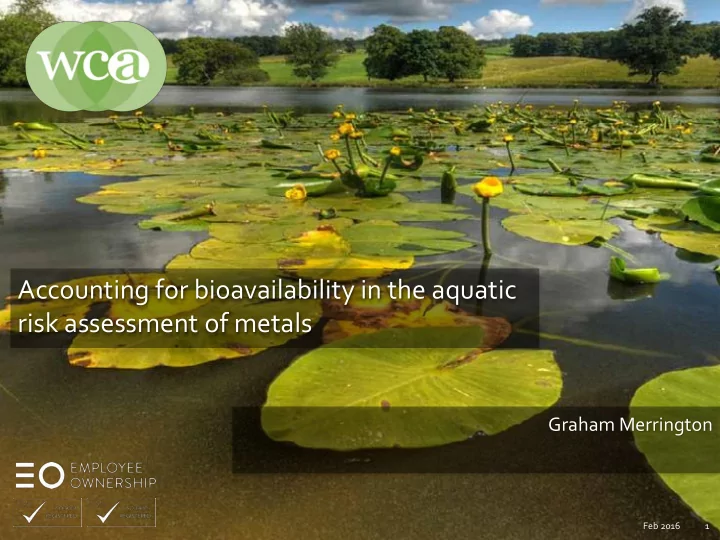

Accounting for bioavailability in the aquatic risk assessment of metals Graham Merrington Feb 2016 1
Introduction Challenges assessing metal environmental risks What is bioavailability and why account for it in risk assessment? Biotic ligand models….. User-friendly tools What do you need? Some examples…… Queries and questions: common problems and issues… Feb 2016 2
Challenges assessing metal environmental risks Metals are ubiquitous Can change chemical form in response to water chemistry The form of the metal influences the ecotoxicity to aquatic organisms Some metals are essential for the functioning of biological systems One limit value doesn’t fit all situations
What is bioavailability? ………..combination of the physico-chemical factors in the water column governing metal behaviour and the biological receptor - its specific pathophysiological characteristics (?) Biological bit Chemistry bit Feb 2016 4
Why account for bioavailability in environmental risk assessment? Predicted ‘stylised’ changes in the ecotoxicity of nickel, expressed as an HC5, for pH, Ca (mg l -1 ) and DOC (mg l -1 ). Individual parameters were varied while the other two parameters remained constant (pH 7, Ca 120 mg l -1 , DOC 2 mg l -1 ). Predicted variation in copper toxicity (HC5) m g Cu l -1 ) as a function of pH and DOC in soft water. Jan 2016 5
Why account for bioavailability in environmental risk assessment? • Hardness based approaches may not be reaching the appropriate conclusions Feb 2016 6
Biotic ligand models Gill Surface Interaction Model – Pagenkopf 1983 » Describes interaction of metals with fish gills (the sites of toxic action) and competition from other ions Humic Ion Binding Model V – Tipping 1992 » Describes binding of metals with natural organic matter and competition from other ions Biotic Ligand Model – Di Toro 2001 » Combines both of these models to describe toxicity as a function of water chemistry Competition and complexation effects are critical in being able to describe the effect of a metal as a function of water quality. Feb 2016 7
Biotic ligand models (continued) These BLM describes competitive interactions for binding by DOC and the biotic ligand. Can quantitatively relate binding to chronic toxicity (fractional occupancy at EC10) But…..these models are quite complex, require in-depth understanding to use Data input requirement (> 10 physico- chemical water parameters) They are very robust tools to make predictions, but complex and …..beautiful 8
User-friendly tools Need a way to mimic the BLM outputs Using a reduced number of inputs In a package the runs on routine office software With loss of accuracy likely to lead to a precautionary assessment The output needs to be….understandable and useable! Back in 2007, the Environment Agency of England and Wales commissioned wca to develop user- friendly tools for copper and zinc…. Feb 2016 9
What do you need? Two tools are available M-BAT (the UK Environment Agency’s) and Bio -met. Both are based on chronic ecotoxicity data and the outputs of the different BLMs for Cu, Ni, Zn (and Mn in the case of M-BAT) Key input parameters are for matched (taken from the same sample at the same time) dissolved organic carbon (DOC), pH and calcium/hardness All three are needed Feb 2016 10
Some examples using bio-met Feb 2016 11
Some examples using bio-met Feb 2016 12
Some examples using bio-met Feb 2016 13
Some examples using bio-met Feb 2016 14
Some examples using bio-met Feb 2016 15
Some examples using bio-met Feb 2016 16
Some examples using bio-met Feb 2016 17
Queries and questions…. Only covers freshwaters (at the moment!) Built in EQS (WQG) for long-term exposures Regulatory tool NOT a replacement for the BLMs Feb 2016 18
Validated boundaries Validation ranges…… Ca, mg L -1 DOC, mg L -1 Metal pH Cu 6.0-8.5 3.1-93 Unlimited Ni 6.5-8.2 2.0-88* Unlimited Zn 6.0-8.(2) 2.0-160 Unlimited Determined by the ranges over which the ecotoxicity tests have been performed. Validated in the field too! Feb 2016 19
Summary • Accounting for bioavailability of trace elements reflects what the aquatic organism actually “experiences”. • Simplified tools allows local assessment of potential metal risks • These tools are already being used by regulators – well validated • Provides an evidence-base for decision making • As with soils though – be wary of using WQG or EQS from other jurisdictions! Feb 2016 20 •
Questions? 21
Some useful (?) material. http://bio-met.net http://www.wfduk.org/search/Bioavailability https://www.nickelinstitute.org/en/MediaCentre/ News/CurrentYear/20160205-Bioavailability.aspx http://bio-met.net/wp-content/uploads/FINAL- TECHNICAL-GUIDANCE-TO-IMPLEMENT- BIOAVAILABILITYNovember-20142.pdf 22
Test presentation | Frome | 18-03-2014 23
Recommend
More recommend